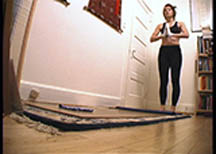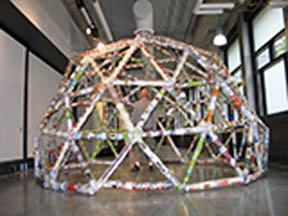Trialogue: Above Is Below
Patricia Briggs did the Trialogue--a talk involving the artist, a critic, and the audience--for the MIA Minnesota Artists Exhibition Series show "Above Is Below," by Sarah Chokyi Bauer and David Hamlow. A version of her talk follows.


It is fair to say that art and religion have little to do with one another in today’s art world. But this hasn’t always been the case. From prehistory through the renaissance in the West, image and objects that today we categorize as “art” were typically tied to ritual or devotional practices. Their original devotional, didactic, or ritual functions tend to be forgotten when they find themselves exhibited in the museum or canonized in the “history of art.”
One could argue that modernist abstraction in the work of artists like Kandinsky and Rothko is a wholly spiritual matter; again, though, the secular aesthetic aspect of such work tends to eclipse the metaphysical in the context of the museum or gallery. Today, philosophical, political, and aesthetic impulses abound in the art world, but almost never does one encounter the spiritual or the devotional in contemporary art. That is why Above Is Below, an exhibition of works by Sarah Chokyi Bauer and David Hamlow at the Minneapolis Institute of Arts, took me by surprise.
Both artists work in a thoroughly contemporary style, yet each in their own way melds aesthetic experimentation with spiritual commitment and daily devotional practice. The profound interweaving of aesthetic and devotional practice witnessed in these artists’ works is so unusual that it pushes at the boundaries of how we define art today and encourages viewers to rethink the slick and (some might argue) soulless intellectualism we so often face in the contemporary art world.
Bauer is a Buddhist, and central to her religious practice is the physical meditation ritual nun’dro, a repetitive ritual prostrating of oneself on the ground in daily forty- to sixty-minute long sessions. Translating as “taking refuge,” this self-imposed ritual labor is a type of meditation that encourages reflection on everyday experience (which it symbolizes), encourages transformation and purification of perception, and allows the practicioner to be liberated from the constraints of ego. One of the goals of nun’dro is to attain a state of selflessness.
Nun’dro lies at the heart of Bauer’s work in the form of thousands of tiny digital video frames that record the artist’s daily ritual prostrations organized into mural-sized digital prints. These large all-over compositions read initially as purely abstracted woven tapestries of color, but as the viewer approaches, the grid pattern of individual video frames emerges. Inside each frame an isolated figure—the artist herself—appears captured in a posture of the nun’dro prostration.
Though Bauer’s images are saturated with this very specific ritual activity, the average viewer may not recognize the nun’dro ritual or understand the meaning of the practice. Despite this, the works have an interesting and powerful impact. These mural-size prints pull the viewer into a quiet, expansive physical and metaphorical space, which reads at once as a cutaway view of a vast honeycomb of urban apartments and as a kind of printout of an electrocardiograph that registers the rhythmic pulse of life. Watching the uncanny narration of repetitive bodily movement, one reads both a singularity of presence and the release or dispersal of the ego that accompanies automatic repetitive practices.
The success of Bauer’s work lies in the fact that it does not read as an “illustration” of a ritual practice or as a Buddhist didactic, but rather that it manages to offer the attentive viewer a taste of the emptying of the ego from the self that is so central to the practice witnessed in the image. Thus the viewer walks away from Bauer’s installation at the MAEP feeling refreshed, as if he or she carries a slightly lighter burden than before.
Hamlow’s religious tradition is Christian, and his approach is to live his religious beliefs in all of his activities. For Hamlow, all daily activities become opportunities for reflection on right and wrong, good and bad, and one’s personal responsibility for the soul’s salvation. His disciplined and vigilant attention to his own actions and their consequences constitutes an important part of Hamlow’s daily devotional practice.
This artist’s commitment to examine his life and to strive be the best person that he can be translates into a highly personal meditation on his most routine activities and his most banal purchased objects, which the artist translates into his artwork. Diet, bad habits, and waste production are areas that Hamlow focuses on for self-examination, potential improvement, and ultimately spiritual redemption.
One of Hamlow’s strategies for self-examination is to collect all of his own garbage. On one hand, this practice is more responsible than sending non-biodegradable garbage to a landfill, and on the other, each bit of trash used in an art work serves as a signifier of sin and the potential for salvation. Thus, the geodesic dome structure that figures centrally in Hamlow’s MAEP installation has been built almost entirely of containers he has collected from the none-too-healthy processed foods he is guilty of eating: “Pringles” potato chips tubes, ice cream cartons, dehydrated soup mixes filled with MSG, and sugary juice concentrates appear alongside packages of medications that aid digestion and counter constipation. Inside the dome is a hanging structure incrusted with cigarette butts–the dirty reminders of the filthy habit the artist has finally managed to give up.
By using his bad or troubling garbage to make art, Hamlow is in a sense transforming his weaknesses and sins into something productive and good. Hamlow preaches with his sculpture by offering his own life up to the viewer as an example of a believer practicing religion in a deeply personal way and in every aspect of his life. In the end, then, the viewer may leave Hamlow’s work—with its focus on the burden of the individual’s responsibility for his or her own salvation—feeling a greater sense of burden than when he or she arrived.